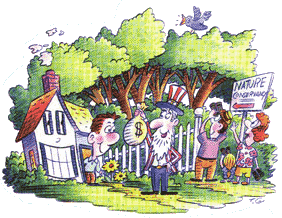Held in Trust
Looking for an innovative way to protect the environment and receive valuable financial rewards? If you or someone in your family owns land that you’d like to see protected, donating the property to a land trust may make sense. It’s probably the only personal statement about controlling urban sprawl you can make that won’t infuriate your accountant.

Working as nonprofit organizations, land trusts provide direct and responsible protection to wide range of lands including forests, wetlands, wildlife habitat, river corridors, watersheds, lake and ocean shorelines, farms, ranches, scenic areas and historic sites. There are several conservation options available through land trusts that enable individual landowners to choose a plan that best meets their financial and conservation goals. By far the most popular option is a conservation easement.
Making it Legal
A conservation easement is an legal agreement between a landowner and a conservation agency that permanently restricts the property’s uses in order to protect its conservation value. When a property owner donates or sells a conservation easement to a land trust, he or she does not give up ownership of the land, but simply relinquishes many of the traditional rights associated with land usage. This may include such commercial benefits as the right to build roads and structures, harvest timber or grow crops. The easement may apply to only a portion of the property, leaving the rest open to the discretion of the landowner. The specific terms of the easement can be tailored to suit both the conservation values and the financial needs of the landowner. The benefit to the owner is twofold. As well as serving as a useful conservation tool, an easement can qualify as a tax-deductible gift in addition to significantly reducing property and estate taxes. In this way, an easement can serve as a flexible tool for family financial planning.
“Conservation easements offer a tremendous combination of advantages to the public, landowners and land trusts,” says Jean Hocker, President of the Land Trust Alliance. “They allow nonprofit land trusts to work directly with landowners to protect our dwindling open spaces for generations to come. At the same time, they leave the land in private ownership and help assure landowners that their heirs won’t be forced to sell the family’s land just to pay estate taxes.”
Here’s how it works. Suppose that an unrestricted piece of land is worth $500,000 on the open market. By restricting land use through a conservation easement, the value of the land drops to $200,000. Since the donation of a conservation easement qualifies as a tax-deductible gift, the value of the donation is considered to be $300,000 or the difference between the original unrestricted fair market value and the new value of the land with the easement. Generally speaking, the more restrictive an easement is, the higher the financial benefit will be. A conservation easement placed on undeveloped land that allows for sub division or development will have a lower value.
The tax assessment on easement-restricted land will usually reflect the property’s lowered value after imposition of the easement. While local regulations will vary, a landowner who places an easement on their property can generally expect to see a reduction in property taxes. In some states, laws have been specifically enacted to provide property tax relief for easement-encumbered land.
Lost Forever
All too often, valuable and cherished land is lost to developers when family members are forced to sell inherited property, as they cannot afford to pay exorbitant estate taxes. In today’s real estate market, the value of unrestricted land can potentially be in the millions of dollars. Since federal estate taxes may be levied at rates as high as 55 percent, selling all or part of the property is often the only way in which family members pay their taxes. However, if a conservation easement has been placed on the land, its fair market value will be reduced, often resulting in substantially lower estate taxes. This reduction can often make the difference between paying hundreds of thousands of dollars in estate taxes and owing virtually nothing. Since taxes laws generally exempt the first $625,000 of assets, heirs receiving easement-restricted property may find that they are absolved from an estate tax altogether.
Overall, conservation easements have helped thousands of families conserve millions of acres of open space, permanently protecting their land and helping to ensure a more financially secure future. For more information on how land trusts can assist you in your personal or family financial planning.

